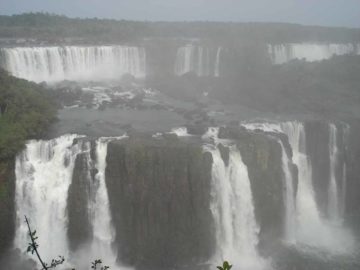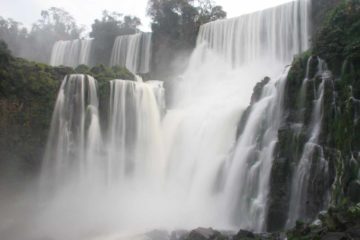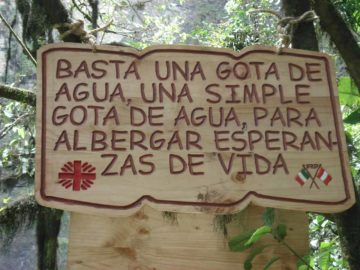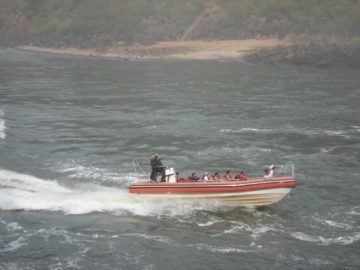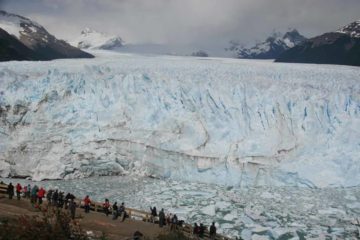About Iguazu Falls / Iguassu Falls
Iguazu Falls (or more accurately Iguazú Falls) is the Spanish name for this mammoth waterfall. You might also see it referred to as Iguassu Falls or Iguaçu Falls if you favor the portugese name. Moreover, you might also see it referred to as Yguazú Falls, which I believe is native Guaraní. In fact, the meaning of the name (originally Guaraní) is said to roughly translate to “big water.” The photo you see at the top of this page certainly attests to its grand nature.
But no matter how you spell or say its name, we have to say that it is indeed a crazy waterfall.
How crazy, you might ask?
Consider a network of 275 different waterfalls spanning an area 3km wide (2km of which is the upper rim of the waterfall) during its normal flow of around 1000 cubic meters per second. It is such a natural wonder that UNESCO designated the falls as a World Heritage Area in 1986.
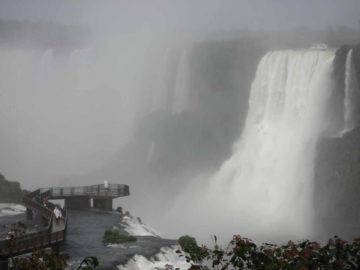
Sitting on the Iguazú River, it is shared by Argentina and Brazil as both countries are separated by the river. Catwalks are built on both sides providing closer (often times mistier and wetter) views of the great waterfall. Paraguay is also near the falls so this region is often referred to as the Triple Frontier.
From what we could tell, during normal flow, the Iguazu River consists of two main parts. These components are the Devil’s Throat section and what I’m calling the Argentina section.
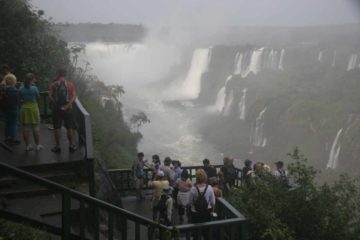
The Argentina section is the part containing numerous segmented waterfalls as a result of islands (the largest of which is the San Martin Island, or La Isla San Martín) splitting up the river. And as suggested by the name I made up for this part, all of these islands are on the Argentina side.
Most of these segmented waterfalls and cascades have names. Just to give you an idea of how many named waterfalls make up this Argentina section, we’ve identified signs pointing out Salto San Martín, Salto Eva, Salto Adán, Salto Bossetti (very impressive), Salto Dos Hermanas, Salto Alvar Nuñez, Salto Guardaparque Bernabé Mendez, Salto Mbigua, Salto Chico, Salto Rivadavía, Salto Escondido, and Salto Lanusse. I’m sure there are others we didn’t even mention.
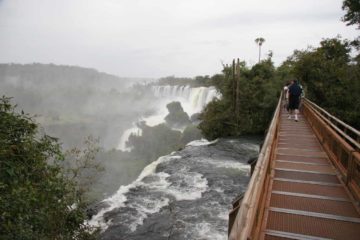
Still with that being said, there was certainly no shortage of activities to do here besides walking the catwalks and soaking in the overlooks. Julie and I have engaged in a couple of of these excursions (including a thrilling boat ride). We’ve discussed our accounts of such excursions in a separate write-up, which you can read about here.
Speaking of catwalks, they afforded us various ways to view and experience Iguazu Falls. Argentina had most of the catwalks while Brazil’s walks mostly focused on panoramas of the Argentinean side as well as closeups of the thunderous Devil’s Throat. We spent a good deal of time walking the main catwalk trails, which were called Paseo Superior (the upper catwalks) and Paseo Inferior (the lower catwalks). We even caught a short train ride that took us to a catwalk to the brink of Devil’s Throat (known as El Paseo de La Garganta del Diablo). On the last day of our visit, we had some limited time exploring the catwalks and trails on San Martin Island after taking a short boat ride.
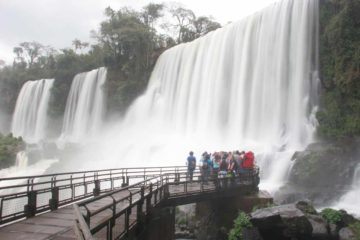
Perhaps, you may have a preference on which side to spend most of your visit or to stay. Since Julie and I have been to both sides, we’ve documented our experiences and made an evaluation of the two sides. Your can read more about our in-depth comparison of the Argentina side versus the Brazil side here.
And with all this going on, we even saw some wildlife such as the banded-tailed coaties (they seemed to have become accustomed to being fed or digging for trash), birds like various species of parrot and toucans, and butterflies of many different colors. I understand that there are even predatory cats like the Jaguar as well as the Puma and Ocelot though I’d imagine sightings of these majestic lords of the jungle would be pretty rare.
Throughout the year, Iguazu Falls can be seen in various states depending on its waterflow as well as how the seasons can affect its surroundings. We made an attempt to summarize our findings in this writeup, which you can get to by clicking here.
Indeed there is much to say about Iguazu Falls, and what we’ve managed to do here merely scratched the surface of the many ways to experience the place. Heck, if the timing’s right, you could even do special tours of the falls by moonlight (something I wish we could’ve done)! Check out the photos and videos below as well as the links to our other write-ups and get ready to experience our favorite waterfall in the world!
Related Top 10 Lists
Trip Planning Resources
Nearby Accommodations
This content is for members only. See Membership Options.Featured Images and Nearby Attractions
This content is for members only. See Membership Options.Visitor Comments:
Got something you'd like to share or say to keep the conversation going? Feel free to leave a comment below... After hours visiting only possible in Brazil November 1, 2016 7:00 pm - You can stay in an expensive hotel within the national park on the Brazil side which gives you unlimited access to the falls after the tourist busses stop running. As such, you can get excellent sunrise and sunset photos, something that is not possible on the Argentina side. ...Read More
After hours visiting only possible in Brazil November 1, 2016 7:00 pm - You can stay in an expensive hotel within the national park on the Brazil side which gives you unlimited access to the falls after the tourist busses stop running. As such, you can get excellent sunrise and sunset photos, something that is not possible on the Argentina side. ...Read More UK Visa Not Required May 4, 2016 12:44 am - we visited Igassu falls last year we were in awe of the natural beauty and splendor of both sides it was spectacular and we would not have missed the experience it is also worthwhile noting that for UK a visa is not required for ether brazil or argentina so I would wholy recommend a visit ...Read More
UK Visa Not Required May 4, 2016 12:44 am - we visited Igassu falls last year we were in awe of the natural beauty and splendor of both sides it was spectacular and we would not have missed the experience it is also worthwhile noting that for UK a visa is not required for ether brazil or argentina so I would wholy recommend a visit ...Read More Argentina side now has Visa fee for US Citizens September 25, 2015 1:56 am - The Argentina government requires a $160 reciprocity fee payment for a Tourist Visa if you're a US Citizen. So the cost difference between Brazil and Argentina is no longer there. Here's a link to the information concerning the Brazil Visa fees (this link is from the US Embassy website). You'll see it's now the same… ...Read More
Argentina side now has Visa fee for US Citizens September 25, 2015 1:56 am - The Argentina government requires a $160 reciprocity fee payment for a Tourist Visa if you're a US Citizen. So the cost difference between Brazil and Argentina is no longer there. Here's a link to the information concerning the Brazil Visa fees (this link is from the US Embassy website). You'll see it's now the same… ...Read More Making Niagara Look LIke A Cup Of Water September 4, 2014 7:37 pm - Iguazu Falls made Niagara look like a cup of water. Niagara is great, but Iguazu was unbelievable. Great experiences and the boat ride into the falls was a thrill of a life time (even though, at one point, I thought I might drown - made the mistake of opening my mouth to breath in). And… ...Read More
Making Niagara Look LIke A Cup Of Water September 4, 2014 7:37 pm - Iguazu Falls made Niagara look like a cup of water. Niagara is great, but Iguazu was unbelievable. Great experiences and the boat ride into the falls was a thrill of a life time (even though, at one point, I thought I might drown - made the mistake of opening my mouth to breath in). And… ...Read More Awesome February 28, 2012 5:12 am - Definitely the most beautiful waterfall in the world. Only thing is that should open from 6am because to view in de morning would be good ...Read More
Awesome February 28, 2012 5:12 am - Definitely the most beautiful waterfall in the world. Only thing is that should open from 6am because to view in de morning would be good ...Read More 1999 Visit April 22, 2010 1:19 am - We visited the falls in 1999 traveling from Sao Paulo to Foz du Iguazu. I can't wait to return since it was beyond amazing!!! Our trip was cut short due to flooding in Sao Paulo which delayed our flight 10 hours and took a day of sightseeing from us . . . but we made… ...Read More
1999 Visit April 22, 2010 1:19 am - We visited the falls in 1999 traveling from Sao Paulo to Foz du Iguazu. I can't wait to return since it was beyond amazing!!! Our trip was cut short due to flooding in Sao Paulo which delayed our flight 10 hours and took a day of sightseeing from us . . . but we made… ...Read More Clueless Tourist – Iguacu Falls January 20, 2010 6:25 pm - The first time I saw Iquacu Falls was from a small jet in 1985. It was my first trip to South America and shamefully I did not know of the Falls. We were flying over a muddy river for a while and it began to appear like a delta...it was splitting into fingers. Then the… ...Read More
Clueless Tourist – Iguacu Falls January 20, 2010 6:25 pm - The first time I saw Iquacu Falls was from a small jet in 1985. It was my first trip to South America and shamefully I did not know of the Falls. We were flying over a muddy river for a while and it began to appear like a delta...it was splitting into fingers. Then the… ...Read More More Than Worth The Trip January 10, 2010 9:49 pm - On our way from USA to Antarctica we purposely made a stop at the Iquazu Falls on the advice of a friend - and it was MORE than worth the trip! We live outside of Buffalo, NY so have been to the Niagara Falls any number of times. I have seen marvelous waterfalls in Iceland,… ...Read More
More Than Worth The Trip January 10, 2010 9:49 pm - On our way from USA to Antarctica we purposely made a stop at the Iquazu Falls on the advice of a friend - and it was MORE than worth the trip! We live outside of Buffalo, NY so have been to the Niagara Falls any number of times. I have seen marvelous waterfalls in Iceland,… ...Read More The Most Amazing Thing (Iguassu Falls) November 4, 2009 4:24 am - I was there when I was 17... and it was the most amazing thing I`ve ever seen in this world!!!! they are really great and deserve to be on the top!!! I was on both side... and Brazil rocks!!!! ...Read More
The Most Amazing Thing (Iguassu Falls) November 4, 2009 4:24 am - I was there when I was 17... and it was the most amazing thing I`ve ever seen in this world!!!! they are really great and deserve to be on the top!!! I was on both side... and Brazil rocks!!!! ...Read More Iguazu Falls – Fee to Cross from Argentina to Brazil October 5, 2009 4:08 pm - It should be noted that there is a $100 fee to cross from Argentina to Brazil. If you hire a taxi and guide in Puerto Iguacu he might be able to get you over without this payment. Both sides are different and are worth seeing. ...Read More
Iguazu Falls – Fee to Cross from Argentina to Brazil October 5, 2009 4:08 pm - It should be noted that there is a $100 fee to cross from Argentina to Brazil. If you hire a taxi and guide in Puerto Iguacu he might be able to get you over without this payment. Both sides are different and are worth seeing. ...Read More Retired Medical Missionary December 23, 2008 6:10 am - I have been twice to Iguassu and can say without a doubt it is the most beautiful and exciting Falls to visit that I have ever seen. It is easily accessible by place to the City of Foz do Iquassu and can be viewed from several vantage points...my favorite was when we went up river… ...Read More
Retired Medical Missionary December 23, 2008 6:10 am - I have been twice to Iguassu and can say without a doubt it is the most beautiful and exciting Falls to visit that I have ever seen. It is easily accessible by place to the City of Foz do Iquassu and can be viewed from several vantage points...my favorite was when we went up river… ...Read MoreVisitor Reviews of this Waterfall:
If you have a waterfall story or write-up that you'd like to share, feel free to click the button below and fill out the form... “Challenges and solutions going from Paraguay to Iguazu falls” June 3, 2015 8:54 pm - “Iguazu Falls” is one of most beautiful places in the world. This wonderful place is located near “Tres Fronteras” where Iguazu River enters river of Parana and national borders of Argentina, Basil and Paraguay comes together. Visitors can enjoy amazing views from Argentinian or Brazilian sides. Unfortunately form Paraguayan side falls cannot be seen. Ones… ...Read More
“Challenges and solutions going from Paraguay to Iguazu falls” June 3, 2015 8:54 pm - “Iguazu Falls” is one of most beautiful places in the world. This wonderful place is located near “Tres Fronteras” where Iguazu River enters river of Parana and national borders of Argentina, Basil and Paraguay comes together. Visitors can enjoy amazing views from Argentinian or Brazilian sides. Unfortunately form Paraguayan side falls cannot be seen. Ones… ...Read More I love this place (Iguazu Falls) April 21, 2015 3:59 pm - Here are some pictures from my trip to brasil and Iguazu Falls in dec.2012 ...Read More
I love this place (Iguazu Falls) April 21, 2015 3:59 pm - Here are some pictures from my trip to brasil and Iguazu Falls in dec.2012 ...Read More Iguazu Falls in Slow Exposure July 19, 2011 9:18 am - Last January I was at Iguazu Falls on both the Argentine side and the Brazilian side. Annoyingly the falls open at something like 10.00am way too late for a photographer. And they close before sunset. I decided to sneakily stay in overnight and get a morning shot from one of the most famous locations. The… ...Read More
Iguazu Falls in Slow Exposure July 19, 2011 9:18 am - Last January I was at Iguazu Falls on both the Argentine side and the Brazilian side. Annoyingly the falls open at something like 10.00am way too late for a photographer. And they close before sunset. I decided to sneakily stay in overnight and get a morning shot from one of the most famous locations. The… ...Read More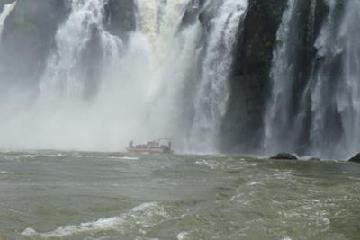 Most Amazing Waterfall! Iguazu Falls May 15, 2010 3:52 pm - I visited Iguazu Falls in February 2010 for two days staying at the Sheraton Hotel in the Park on the Argentina side. Two days was not long enough as I did not make it to the Brazil side. We took a boat trip into the bottom of the falls thinking that it would be like… ...Read More
Most Amazing Waterfall! Iguazu Falls May 15, 2010 3:52 pm - I visited Iguazu Falls in February 2010 for two days staying at the Sheraton Hotel in the Park on the Argentina side. Two days was not long enough as I did not make it to the Brazil side. We took a boat trip into the bottom of the falls thinking that it would be like… ...Read More
